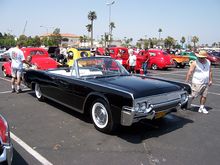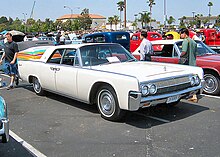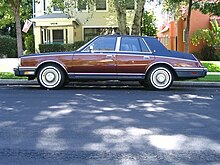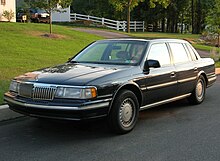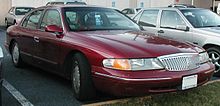Lincoln Continental
| Lincoln Continental | |
|---|---|
| Production period: | 1940–1948 1956–1980 since 2016 |
| Class : | Upper class |
| Body versions : | limousine |
Lincoln Continental is a line of luxury vehicles from the Lincoln brand belonging to Ford Motor Company . Since the debut in 1940, about 10 generations have been created, depending on the counting method. The Lincoln Continental has become the epitome of the American road cruiser over the years . The Continentals of the 1960s are particularly well-known with their suicide doors . John F. Kennedy was shot dead in an open special vehicle of this generation . Over the years, the position of the Continental changed. Until 1981, Continental was the name for the largest Lincoln models. Thereafter, these vehicles were given the designation Town Car , while the name Continental was transferred from 1982 to smaller, but more expensive sedans that were to compete with the Cadillac Seville .
After a 14-year hiatus, Lincoln has had a model called the Continental in its range since the end of 2016. This succeeds the Lincoln MKS .
Lincoln Continental (1940–1942 and 1946–1948)
The name "Continental" was first used in 1940 for an equipment variant of the Lincoln Zephyr . As in the entire US automotive industry, production was interrupted in the winter of 1941/42 in favor of the production of war goods. From late 1945, Lincoln resumed manufacturing luxury vehicles. It followed up on the previously produced 1941 models, which, however, had a revised radiator grille. The 130 hp, approximately 5000 cm 3 twelve-cylinder engines were able to bring the car to a top speed of 155 km / h. Some versions were primarily intended for chauffeur use.
From 1949 to 1955, Lincoln did not use the Continental name.
1956–1960: The models of the Continental Division
From 1956 to 1960, the Ford Motor Company offered various vehicles known as Continental. Formally, they were not Lincoln's, but were manufactured by the Continental Division , another Ford subsidiary founded specifically for this purpose in 1952, which was located in the market via Lincoln. The Continental models were offered alongside Lincoln's standard Capri and Premiere models.
The Continental Division's first model was the Continental Mark II , an exclusive luxury coupe that was the most expensive American automobile of its time at around $ 10,000 . With the designation Continental Mark II, Ford followed up on the first Continental of the 1940s, which was seen as a stylistic milestone. This vehicle was an in-house development and shared few components with the regular Lincoln models. Only 1,800 copies were produced from 1956 to 1957. In 1958, 1959 and 1960 other vehicles were offered under the name Continental. They were given the names Continental Mark III, Mark IV and Mark V (again without the Lincoln addition), but - unlike the Continental Mark II - were no longer independent models, but merely exclusively equipped and high-priced versions of the contemporary Lincoln basic models they looked very much alike.
From 1961 the name Continental became the model name for Lincoln's standard vehicles. The cars were now called Lincoln Continental (again) ; The manufacturer was Lincoln or the Lincoln Mercury Division.
The Continental Mark Series was re-established in 1969 with the Continental Mark III . It was a luxury coupé that, based on the Mark II from 1956, did not have the model designation Lincoln, but - unlike the prototype - was actually manufactured by the Lincoln-Mercury division with high-volume technology from Ford. The nomenclature has been a source of confusion since 1969, as Lincoln's standard models continued to be referred to as the Lincoln Continental (with the corporate suffix Lincoln).
1961 to 1980: full-size models
Between 1961 and 1980, Lincoln's full-size models were named (Lincoln) Continental. At times they were the longest and heaviest series vehicles made in the USA. A general distinction is made between the models of the so-called fourth generation (1961 to 1969) and those of the fifth generation (1970 to 1979). Within the respective generations, there were again some stylistic and technical modifications over the course of the model years.
Model years 1961–1969
With the 1961 model year, Lincoln presented a completely redesigned Continental model. The vehicle, designed by a team led by Ford chief designer Elwood Engel, ended the flourish and tailfin era of the 1950s. Instead, the lines of the Continental were straight and flowing, the surfaces were smooth and spacious. At the same time, there was no excessive decoration with chrome parts. The ninth Continental changed the image of the Lincoln brand overnight. It was the first car to receive the prestigious "Industrial Design Award" from the Industrial Designers Institute (IDI) in the USA ; The reason for the decision was that the Continental made an “outstanding contribution to the simplicity and elegance of automobile design”. Like its predecessor from 1958, this Continental was partly self-supporting (“unitized body” or “unibody”). Engel's excellent design goes back to a design that he originally proposed for the Ford Thunderbird in 1958, but which was not taken into account there. It was redesigned for the Lincoln Continental (longer wheelbase, four instead of two doors). The Continental was the first production car with curved side windows. It was built in the Wixom factory on parallel tapes with the Thunderbird. With this he was technically closely related; the Continental platform was an extended version of the Thunderbird. Regardless of its completely independent body, the Continental also shared many other mechanical parts with the third-generation Ford Thunderbird .
The Continental was available in several body versions:
- From 1961 to 1969 it was offered as a four-door sedan. The rear-hinged rear doors , which were only available in this form from Lincoln in the 1960s, were a stylistic peculiarity .
- From 1961 to 1967, a four-door convertible was available as an alternative, which - with the exception of the roof construction - corresponded to the sedan. The side windows were fully retractable, so there were no frames. The Continental shared the convertible top mechanism with the Thunderbird. It is a further development of the system that Ford and Lockheed originally developed for a retractable metal roof for the Continental Mark II. It was too expensive there, so it was finally used in the Ford Fairlane 500 Skyliner Retractable from 1957 to 1959 . As a technical necessity, this resulted in a trunk flap hinged at the rear, under which the completely collapsible fabric roof sunk. The disadvantage of the restricted access to the trunk is offset by a spectacular opening and closing process. Electrically operated screws in the A-pillar pull the convertible top watertight when it is closed; manual locking, which was common at the time, is no longer necessary. The Continental was America's first four-door convertible since the Frazer Manhattan of 1951.
- In 1966, a two-door hardtop coupé in the so-called Coke-Bottle style with a very wide C-pillar and curved rear fenders was introduced - not to be confused with the Continental Mark III presented in 1969 .
- On behalf of Lincoln, the American bodywork manufacturer Lehmann-Peterson constructed various elongated sedans based on the Continental, mostly with a wheelbase of 4.06 meters (160 inches). They usually had a closed structure; some versions were also designed as a convertible. They were particularly used in parades. Other body manufacturers such as Armbruster , Stageway or Andy Hutton also offered sedan versions of the Continental.
The appearance and technology of the Continental were modified almost every year. The radiator grille was changed several times, the same applies to the shape and surrounds of the light units. In 1966, the stylists gave the car an extended radiator grille, which anticipated the " Knudsen nose " that would later be typical of Ford . The name goes back to the Ford manager Semon E. "Bunky" Knudsen. Most of the Ford models newly introduced or revised under his time had a grille that broke through the bumper line. This also applies to European Ford products such as the Ford Taunus TC . With the 1964 model year, Lincoln extended the wheelbase by 7.5 centimeters. This resulted in more knee room for the passengers in the rear.
In the 1969 model year there was the first "Town Car" interior trim package for the Continental (for an additional charge of $ 249); in later years the name was often used for a particularly luxurious trim level of the Continental.
The Lincoln Continentals of the 1960s are sought-after classic cars today. In particular, models of the first three years of age achieve unusually high used car prices for American vehicles. For four-door closed Lincoln Continental from 1961 and 1962, if they are in excellent condition, up to 26,000 euros are charged; the convertible version reaches prices of over 45,000 euros.
Model years 1970 to 1974
In the 1970s, as part of the platform strategy for the Lincoln Mercury Division (LM), Lincoln began to use Ford production parts and engines to an increasing extent.
The Continental was completely redesigned for the 1970 model year. Instead of a self-supporting body, the new generation had a frame made of steel chassis to which the body was connected. The chassis was the same as the Ford LTD and the Mercury Marquis ; Cost reasons in particular played a role in this decision. Up to MJ57, the Lincoln & Continentals still had independent engines, from 1958 the V8 engine with 462 cubic inches (7571 cm³) of the newly founded and short-lived Mercury-Edsel-Lincoln Division was installed, which from the 1969 model year onwards was replaced by the Ford V8 460 cubic inches (7538 cm³) was replaced.
The Continental was now available as a four-door sedan and as a two-door coupé. There was no factory-made convertible; some body manufacturers, however, offered convertible conversions. In terms of style, the models of the 1970s differed considerably from their predecessors. The four-door Continentals had front-hinged rear doors and folding headlights . The Ford stylists had given up the light, sober lines of their predecessors in favor of a heavy, massive design; the vehicles now looked bulky, even if they were between 200 and 300 kg lighter than the 1969 models. A 7.5 liter eight-cylinder engine served as the drive.
Model years 1975 to 1979: "The last dinosaurs"
For the 1977 model year, Lincoln redesigned the body of the Continental models. The vehicles had straight lines; the previous swing of the hips over the rear wheels was omitted. Instead, the rear fenders received a step-like elevation, citing a design feature of the Continental Mark II from 1956. Another styling feature was the opera window in the C-pillar. Regardless of the energy crisis of 1973 , the Continentals remained large, heavy vehicles that were still equipped with fuel-intensive engines of up to 7.5 liters displacement. It was not until the 1978 model year that Lincoln introduced a 6.6 liter eight-cylinder as the standard engine. (for California as early as 1977); the 7.5 liter version remained as an option for this model year, from 1979 on there was only the 6.6 liter engine.
The Continentals sold well into 1979 regardless of the two oil crises of the 1970s. From 1977 the models experienced a noticeable upswing, as a result of which the production figures increased by almost 50 percent. The main reason for this was that Lincoln only accepted the general downsizing of the American automobile manufacturers very slowly. From 1977 onwards, the Continental was the last American full- size sedan: Cadillac had significantly reduced the DeVille and Fleetwood series at the end of 1976, and Chrysler's big New Yorker ran out of production a little later . In the 1979 model year, Lincoln sold 92,600 Continental models. In the German press, the vehicles were sometimes referred to as "the last dinosaurs".
Model year 1980
It was not until the second oil crisis in 1979 that the classic Continentals came to an end. From 1980, the vehicles were built increasingly lighter and equipped with smaller engines. The Continental presented for model year 1980 was based on Ford's smaller Panther platform , which had a wheelbase that was 23 cm shorter and its length was 40 cm. Regardless of this, the interior dimensions of the car did not decrease compared to its predecessor; some dimensions even increased.
In 1980 the Lincoln Continental was the base model in the Lincoln range. The higher quality, much better equipped version was sold during this time as the Continental Mark VI (without the addition "Lincoln"), which was available - for the first time in the history of the Mark Series - not only as a two-door coupé, but also as a four-door sedan. Technically and in terms of design, the Mark VI largely corresponded to the Continental. Outwardly, the models differed mainly in their front section: while the Continental had four uncovered rectangular headlights, the Mark VI had pop-up headlights. An Opera Window , an oval window in the C-pillar, was also reserved for the Mark VI .
With the 1981 model year, the Lincoln Continental became the Lincoln Town Car without any technical changes . As a result of the renaming, there was also a two-door model of the Lincoln Town Car, exclusively in 1981. There was no independent model of the Continental in 1981. The name Lincoln Continental was not used again until 1982 for a number of smaller, but high-quality sedans.
Special structures for the full-size continental
Some US presidents and other heads of state used extended Continental limousines as representative vehicles or state cars .
The Michigan-based body construction company Andy Hotton Associates has been manufacturing a number of special bodies based on the Continental on behalf of individual customers since 1970. Numerous limousines with extended wheelbases were created, differing in detail; In addition, Andy Hotton produced several convertibles based on the two-door Continental, which carried the radiator grille of the Continental Mark IV .
Finally, some were hearses on Lincoln-based manufactured. Many of these vehicles stayed in service for a long time. Some were used at state funerals for decades. On the occasion of the funeral services for the North Korean ruler Kim Jong-Il in December 2011, several Continental built between 1975 and 1979 led a funeral procession that led through Pyongyang . One vehicle carried a larger than life portrait of the deceased, and a second carried the coffin.
1982-2002: Intermediates
For the 1982 model year, Lincoln transferred the traditional name Continental to a smaller series that was positioned below the large, now called Town Car, full-size models in the intermediate segment. The new, smaller Continental replaced the unsuccessful Lincoln Versailles . It now competed with the Cadillac Seville and was significantly more expensive than the Town Car. Lincoln produced three series of the Intermediate Continentals until 2002, after which Lincoln gave up the model name in favor of a three-digit letter code.
Model years 1982–1987
The first generation of Intermediate Continentals was based on the Fox platform from Ford. It was introduced in 1979 with the mid-range model Ford Fairmont and a little later also formed the basis for the contemporary versions of the Mustang and Thunderbird as well as the corresponding Mercury offshoots . The wheelbase of the new Continental was 22 cm shorter than its predecessor with the same name, and the external length was reduced by 45 cm. While the Cadillac Seville has been based on a front-wheel drive platform since 1980, Ford stuck to rear-wheel drive for its Seville competitor.
The Continental was only available as a four-door notchback sedan. The body was independent. In contrast to the unsuccessful Versailles, which the Continental replaced, there were no longer any sheet metal parts that could be interchanged with Ford models. A special feature of the Continental was a hinted "Hooper-Heck", which quoted a stylistic device of the current Cadillac Seville. This design was to take up the design of classic British sedans such as the Rolls-Royce bodies by Hooper Coachbuilders . This corresponded (again as with Cadillac) to a wide color stripe on the sides of the car, which curved downwards towards the rear. Many cars also had a two-tone paint job to support them. The front section was revised for the 1984 model year. It got a rounder shape. The indicators, which were initially positioned next to the headlights and protruded into the side of the fenders, were now under the headlights. There were no further design changes during the five-year production period.
In the first model year, the Continental was equipped with a 4.9-liter eight-cylinder V-engine as standard; a 3.8-liter, six-cylinder V-engine was optionally available for the same price. Both engines were equipped with carburetors. In the second model year they were no longer offered. The standard engine was now the 4.9-liter V8 with gasoline injection, which was also available in the Town Car. It remained that way until the end of production in 1987. The power transmission was carried out as standard by a four-speed automatic transmission from Ford. In the 1984 and 1985 model years, the Continental and the four-door Coupé Mark VII were optionally available with a 2.4-liter six-cylinder turbodiesel for an extra charge. got the Ford from BMW . It was coupled with a four-speed automatic from ZF . In two years only 1500 Continental with diesel engines were sold.
For the Continental, Lincoln took up the tradition established in the Mark Series in the 1970s of offering certain equipment versions in coordination with internationally known designers. This included special equipment components and color combinations. For example, there was a Givenchy and a Valentino package in individual years . The designer packages increased the base price by US $ 3,100 to US $ 3,500.
Model years 1988–1994
In 1988 the second intermediate series of the Continentals appeared. It was technically the same as the mid-range models Ford Taurus and Mercury Sable . Lincoln thus converted the Continental series to front-wheel drive. Eight-cylinder engines were no longer available; the only engine was a 3.8 liter six-cylinder V-engine, which initially made 140, later 150 and from 1993 finally 160 hp. The structure was now designed in many places according to aerodynamic aspects. Broadband headlights were used in the front. The bumpers were fully clad and integrated into the body. The doorways protruded into the roof and there were no more rain gutters. For the first time, Lincoln did without the hint of the spare wheel cover on the trunk, which had become a trademark of the Continental range over the years. The designer series were abandoned. The equipment lines were instead called Executive and Signature Series . In 1990, Lincoln celebrated the 50th anniversary of the Continental range. To celebrate, a particularly high-quality 50th Anniversary Edition was launched, which differed from the basic models in terms of special wheels and a two-tone interior.
Model years 1995–2002
The last Continental series appeared in 1994. It had a newly designed, very aerodynamic body with a strong resemblance to the Continental Mark VIII Personal Luxury Coupé . Technically, the relationship with the Ford Taurus remained. With this generation, Lincoln returned to eight-cylinder engines in the Continental; Standard engine was a 4.6 liter V8 engine with an output of 260 hp.
Continental X (since 2016)
| Tenth generation | |
|---|---|
|
Lincoln Continental (since 2016) |
|
| Production period: | since 2016 |
| Body versions : | limousine |
| Engines: |
Gasoline engines : 2.0-3.7 liters (177-298 kW) |
| Length: | 5115 mm |
| Width: | 1912 mm |
| Height: | 1491-1492 mm |
| Wheelbase : | 2994 mm |
| Empty weight : | 1841-2151 kg |
A study of the new Lincoln Continental had already been presented at the New York International Auto Show 2015. A year later, the production model of the Lincoln Continental was presented at the North American International Auto Show , which has been sold since the end. The vehicle is based on the same platform as Ford Fusion , Lincoln MKZ and Lincoln MKS . The focus is on classic luxury and should also convince for the first time on the Chinese market with plenty of space and comfort on the rear seats and lots of chrome.
The Continental cannot be clearly assigned to any vehicle class. If you look at the sales price, the competing vehicles would be found in the upper middle class . If you choose the criterion of size and space, an assignment to the upper class would be possible. But the end of production has also been announced for this model series. In the USA still in 2020, for China in 2021. The causes are the continued shrinking market for classic sedans and a consequent further focus on the SUV segment.
80th Anniversary special model
In December 2018, Lincoln presented a version of the Continental with portal doors, limited to 80 copies . The model pays homage to a specially built luxury model from 1939. In October 2019, Lincoln announced that it would build another 150 units for the 2020 model year.
Technical specifications
| 2.0 (China) | 3.0 V6 (China) | 2.7 V6 (USA) | 3.0 V6 (USA) | 3.7 V6 (USA) | ||
|---|---|---|---|---|---|---|
| Construction period | since 01/2019 | 11/2016–05/2020 | since 11/2016 | |||
| Engine characteristics | ||||||
| Engine type | R4 petrol engine | V6 petrol engine | ||||
| Displacement | 1999 cc | 2956 cc | 2688 cc | 2956 cc | 3726 cc | |
| Compression ratio | 9.7: 1 | 9.5: 1 | 10.5: 1 | 9.5: 1 | 10.5: 1 | |
| Max. Power at min −1 | 177 kW (241 PS) / 5000 | 192 kW (261 PS) / 5500 | 278 kW (378 hp) / 5500 | 250 kW (340 PS) / 5700 | 298 kW (405 PS) / 5750 | 227 kW (309 PS) / 6500 |
| Max. Torque in min -1 | 386 Nm / 2500 | 570 Nm / 2500 | 515 Nm / 3500 | 542 Nm / 2750 | 380 Nm / 2500 | |
| Power transmission | ||||||
| Drive, as standard | Front wheel drive | all wheel drive | Front wheel drive | all wheel drive | Front wheel drive | |
| Drive, optional | - | (All wheel drive) | - | (All wheel drive) | ||
| Gearbox, as standard | 6-speed automatic transmission | |||||
| Readings | ||||||
| Top speed | 229 km / h | k. A. | ||||
| Acceleration, 0-100 km / h | k. A. | 7.7 s | 5.8 s | k. A. | ||
| Fuel consumption over 100 km | 8.7 l super | 8.5 l super | 10.7 l super | 11.2 l super (11.8 l super) |
12.4 l super | 11.8 l super (12.4 l super) |
| Tank capacity | 74 l | 68 l | ||||
literature
- Paul R. Woudenberg: Lincoln and Continental 1946–1980 - The classic Postwar Years . Motorbooks International, Osceola WI (USA) 1993 (new edition), ISBN 0-87938-730-0 .
- Beverly Rae Kimes, Richard M. Langworth (Eds.): The Golden Anniversary of the Lincoln Motor Car 1921–1971 . Automobile Quarterly, New York 1970
- Richard M. Langworth: Encyclopedia of American Cars 1930-1980 . Beekman House, New York 1984, ISBN 0-517-42462-2 .
- Encyclopedia of American Cars from 1930 . Ed. Consumer's Guide, Publications International 1993, ISBN 0-7853-0175-5 .
- G. Marshall Naul, R. Perry Zavitz (Eds.): The Specification Book For US Cars 1930-1969 . Motorbooks International, 1980, ISBN 0-87938-068-3 .
- Jerry Heasley: The Production Figure Book For US Cars . Motorbooks International, 1977, ISBN 0-87938-042-X .
- Tad Burness: American Car Spotter's Guide, 1920-39 . Motorbooks International, ISBN 0-87938-026-8 .
- Tad Burness: American Car Spotter's Guide, 1940-65 . Motorbooks International, ISBN 0-87938-057-8 .
- Tad Burness: American Car Spotter's Guide, 1966-80 . Motorbooks International, ISBN 0-87938-102-7 .
- Tad Burness: American Car Spotter's Guide, 1981-90 . Motorbooks International, ISBN 0-87938-428-X .
Web links
Individual evidence
- ^ Lincoln Continental. In: auto motor und sport . Retrieved June 4, 2009 .
- ↑ Reinhard Lintelmann: 1000 automobiles - history - classics - technology . Naumann & Göbel, 2005, ISBN 3-625-10543-8 , p. 284
- ↑ Oldtimer Market. Used car prices 2011. 324.
- ^ Langworth: Encyclopedia of American Cars 1930-1980, p. 416.
- ↑ Brochure for the 1981 Lincoln Town Cars
- ^ History of the company Andy Hotton Associates with numerous images of converted Lincoln models on the website www.coachbuilt.com (accessed October 3, 2011).
- ↑ Documentation on the website www.autobild.de from December 28, 2011 . There, the cars are incorrectly referred to as "Lincoln Town Car".
- ↑ Illustration of a Givenchi-Continental in a sales prospectus from 1984 on the website www.lov2xlr8.no (accessed on January 14, 2018).
- ↑ Peter R. Fischer: American way of Luxus , in: AutoBild from January 13, 2016.
- ↑ Karl Brauer: 2017 Lincoln Continental: A Full-Fledged Luxury Car Worthy Of The Classic Name on Forbes.com from November 4, 2016.
- ↑ Archived copy ( memento of the original from March 21, 2016 in the Internet Archive ) Info: The archive link was inserted automatically and has not yet been checked. Please check the original and archive link according to the instructions and then remove this notice.
- ↑ www.focus.de
- ↑ Marcel Sommer, Uli Baumann: Lincoln Continental with portal doors: special anniversary model is coming back. In: auto-motor-und-sport.de. October 7, 2019, accessed October 7, 2019 .
| Lincoln models timeline from 1970 to present | |||||||||||||||||||||||||||||||||||||||||||||||||||
|---|---|---|---|---|---|---|---|---|---|---|---|---|---|---|---|---|---|---|---|---|---|---|---|---|---|---|---|---|---|---|---|---|---|---|---|---|---|---|---|---|---|---|---|---|---|---|---|---|---|---|---|
| Type | 1970s | 1980s | 1990s | 2000s | 2010s | 2020s | |||||||||||||||||||||||||||||||||||||||||||||
| 0 | 1 | 2 | 3 | 4th | 5 | 6th | 7th | 8th | 9 | 0 | 1 | 2 | 3 | 4th | 5 | 6th | 7th | 8th | 9 | 0 | 1 | 2 | 3 | 4th | 5 | 6th | 7th | 8th | 9 | 0 | 1 | 2 | 3 | 4th | 5 | 6th | 7th | 8th | 9 | 0 | 1 | 2 | 3 | 4th | 5 | 6th | 7th | 8th | 9 | 0 | |
| Middle class | LS | Zephyr / MKZ | MKZ | ||||||||||||||||||||||||||||||||||||||||||||||||
| upper middle class | Versailles | Continental VII | Continental VIII | Continental IX | MKS | Continental | |||||||||||||||||||||||||||||||||||||||||||||
| Upper class | Continental V | Continental VI / Town Car I. | Town Car II | Town Car III | |||||||||||||||||||||||||||||||||||||||||||||||
| Personal Luxury | Continental Mark III | Continental Mark IV | Continental Mark V | Continental Mark VI | Mark VII | Mark VIII | |||||||||||||||||||||||||||||||||||||||||||||
| SUV | MKC | Corsair | |||||||||||||||||||||||||||||||||||||||||||||||||
| MKX | MKX / Nautilus | ||||||||||||||||||||||||||||||||||||||||||||||||||
| Aviator | MKT | Aviator | |||||||||||||||||||||||||||||||||||||||||||||||||
| Navigator I | Navigator II | Navigator III | Navigator IV | ||||||||||||||||||||||||||||||||||||||||||||||||
| Pick up | Blackwood | Mark LT | Mark LT | ||||||||||||||||||||||||||||||||||||||||||||||||

